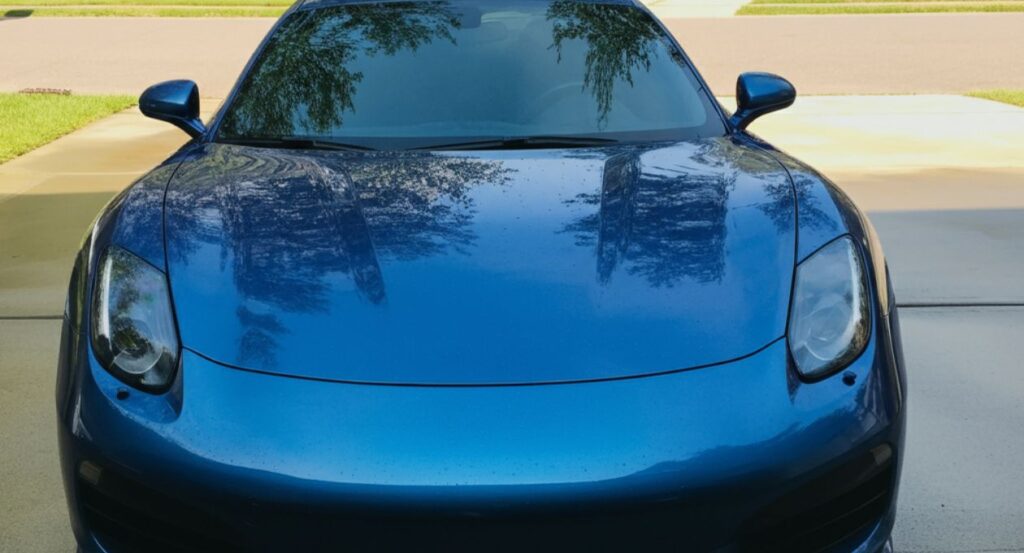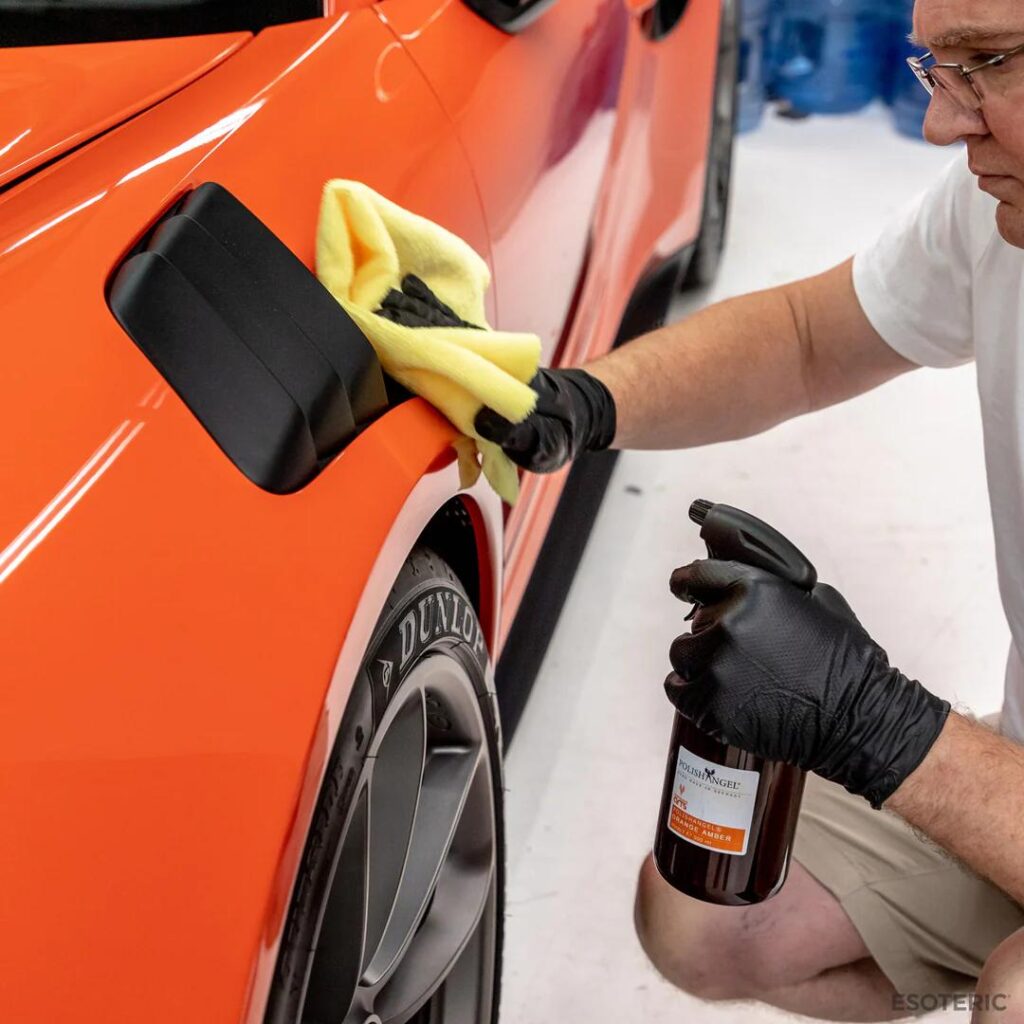As an Amazon Associate, I earn from qualifying purchases
Water spots on your car’s paint can be frustrating, especially after you’ve just finished washing it. Those white, chalky marks that appear across your hood, doors, and windows aren’t just unsightly—they can actually damage your car’s finish if left untreated.
Water spots form when mineral-rich water evaporates on your car’s surface, leaving behind calcium, magnesium, and other mineral deposits. Hard water makes this problem worse, creating more stubborn spots that require special attention. The good news is that removing water spots doesn’t have to be complicated or expensive.
With the right tools, techniques, and a little patience, you can restore your car’s shine and protect its paint for the long term. This guide will walk you through proven methods for removing water spots and share practical tips to prevent them from coming back.
Table of Contents
Why Water Spots are Harmful to Your Car’s Paint
Water spots might seem like a minor cosmetic issue, but they can cause serious damage to your vehicle’s finish over time. Understanding how they form helps explain why quick action is so important.
When water sits on your car’s surface and evaporates, it leaves behind concentrated mineral deposits. These minerals create a slightly acidic residue that can etch into your car’s clear coat. The longer these spots remain, the deeper they penetrate, making them harder to remove and potentially causing permanent damage.
Hard water accelerates this process because it contains higher concentrations of calcium and magnesium. Cars parked outside are particularly vulnerable, as sun exposure speeds up evaporation and intensifies the etching process. Hot surfaces make the problem worse by causing water to evaporate almost instantly, creating dense mineral concentrations.
Over time, untreated water spots can cause permanent pitting in your car’s paint. What starts as a surface-level mineral deposit can become a deep etch that requires professional polishing or even paint correction to fix. This type of damage significantly reduces your car’s resale value and compromises the protective clear coat that shields your paint from UV rays and environmental contaminants.
How to Get Rid of Water Spots on Car (Step-by-Step)

Removing water spots requires the right approach and tools. Follow these steps for the best results:
Step 1: Start with a Clean Surface
Wash your car thoroughly with car soap and rinse completely. This removes dirt and debris that could scratch your paint during the spot removal process. Work in shade and ensure the surface isn’t hot to the touch.
Step 2: Wipe Away Fresh Water
Use a clean microfiber towel to gently remove any remaining water droplets. Pat rather than drag the towel across the surface to minimize scratching. This prevents new spots from forming while you work on existing ones.
Step 3: Apply Water Spot Remover
Choose either a commercial water spot remover or create a DIY solution using equal parts white vinegar and distilled water. Apply the solution to a small section at a time using a microfiber cloth. Let it sit for 2-3 minutes to break down mineral deposits.
Step 4: Use a Clay Bar for Stubborn Spots
For spots that won’t come off with liquid removers, use a clay bar with proper lubrication. Work the clay gently over the affected area in straight lines rather than circular motions. The clay will pick up embedded minerals that other methods can’t reach.
Step 5: Rinse and Dry Thoroughly
After treating each section, rinse immediately with distilled water if possible, or clean tap water if distilled isn’t available. Dry completely with a clean microfiber towel to prevent new spots from forming.
Step 6: Protect with Wax or Sealant
Once all spots are removed and the surface is completely dry, apply a coat of car wax or paint sealant. This creates a protective barrier that makes future water spots easier to remove and helps prevent mineral deposits from bonding to your paint.
Best Tools and Products to Remove Water Spots
Having the right tools makes water spot removal more effective and safer for your car’s paint.
Essential Tools:
- High-quality microfiber towels (at least 300 GSM)
- Clay bar kit with lubricant
- Spray bottles for solutions
- Soft-bristled detailing brush for textured surfaces
Commercial Products:
Popular water spot removers include Chemical Guys Water Spot Rx, Meguiar’s Water Spot Remover, and Adam’s Water Spot Remover. These products are specifically formulated to dissolve mineral deposits without damaging paint or clear coat.
Natural Remedies:
White vinegar mixed with distilled water offers an affordable alternative to commercial products. The mild acetic acid in vinegar effectively dissolves calcium and magnesium deposits. However, always dilute vinegar and test it on an inconspicuous area first.
Avoid using lemon juice, baking soda pastes, or household cleaners not designed for automotive use. These can be too abrasive or acidic, potentially causing more damage than the water spots themselves.
Preventing Future Water Spots on Your Car
Prevention is always easier than removal. These strategies will help keep water spots from forming:
Timing Matters: Wash your car in shade during cooler parts of the day. Early morning or late afternoon works best. Avoid washing in direct sunlight or when surfaces are hot.
Dry Immediately: Never let your car air dry after washing. Use clean microfiber towels or a car-specific chamois to dry all surfaces immediately after rinsing.
Choose Your Location: Park in covered areas when possible. Garages, carports, or even large trees can provide enough shade to slow evaporation and reduce spot formation.
Water Quality: If your area has very hard water, consider using distilled water for the final rinse. This eliminates the minerals that cause spots in the first place.
Regular Protection: Maintain a coat of wax or sealant on your car. These products create a barrier that prevents minerals from bonding directly to your paint, making any spots that do form much easier to remove.
Frequently Asked Questions
Can I remove water spots from my car without damaging the paint?
Yes, when done correctly with appropriate products and techniques. Always use clean microfiber towels, work in shade, and avoid abrasive materials. Test any product on a hidden area first.
Is vinegar safe to use on car paint?
White vinegar diluted with equal parts distilled water is generally safe for removing water spots. However, never use vinegar at full strength, and always rinse thoroughly after application. Test on an inconspicuous area first.
How often should I clean water spots off my car?
Remove water spots as soon as you notice them. Fresh spots are much easier to remove than ones that have been sitting for weeks. Regular washing and drying prevents most spots from forming.
Can I use household products like baking soda to remove water spots?
Avoid baking soda pastes or other abrasive household cleaners. These can scratch your car’s clear coat. Stick to products specifically designed for automotive use or diluted white vinegar.
What’s the difference between water spots and other car stains?
Water spots are typically white or chalky and feel slightly raised or textured. They’re caused by mineral deposits, while other stains might be from tree sap, bird droppings, or environmental fallout. Each requires different removal techniques.
Keep Your Car Spotless with Regular Care
Water spots don’t have to be a permanent problem. With the right techniques and regular maintenance, you can keep your car’s paint looking showroom fresh. Remember that prevention through proper washing and drying techniques is your best defense against water spots.
Start with gentle methods like diluted vinegar solutions before moving to stronger commercial products. Always work in shade, use quality microfiber towels, and protect your paint with wax or sealant after spot removal. Your car’s finish will thank you with lasting shine and protection.
As an Amazon Associate, I earn from qualifying purchases


